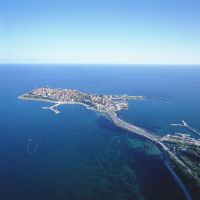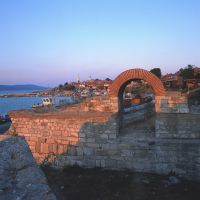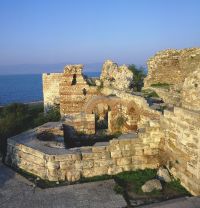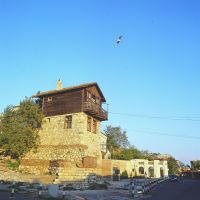 Nessebar is one of the most ancient towns in Europe, arising more than 3200 years ago. The ancient town is situated on a small peninsula, long 850 m and wide 350 m, linked with the mainland with a narrow isthmus.
Nessebar peninsula - The Antic Messambria, called in the Early Middle Age Messemvria and later – Nessebar, was settled at the end of the Bronze Age. Ancient Thracian people called it Melsambria, meaning in their language “town of Melsas”- from the name of the legendary founder of the settlement and Thracian word for town “bria”. Messambria has had two convenient harbors: northern and southern, where remains and equipments of ancient ships have been founded even nowadays.
The first Greek colonizers of Dorian origin arrived here at the end of 6th century BC. The town grew up quickly and turned into a typical Greek polis with the correspondent structure, functions and government. The town was gradually surrounded by massive fortification wall; residential neighborhoods, temples, a gymnasium and a theater were built. Numerous crafts have been developed - especially metal treatment. Messambria began to mint its own coins in the first half of 5th century BC – silver drachms and obols and later bronze coins. The town reached its big prosperity 3rd – 2nd century BC when it minted its own gold emission. Nessebar maintained commercial links with the towns from the Black, Aegean and Mediterranean coast. Material expressions of its rich economic, cultural and spiritual life are the numerous finds from this period, presented in the Archaeological museum.
 In 72 BC the town was conquered without resistance by Roman armies. After a temporary occupation in the beginning of 1st century it was included permanently in the limits of Roman Empire. Messemvria, as the town began to be called, preserved untouched its fortification walls and big public buildings. Messemvria continued to mint own bronze coins and remained an important trade and cultural center along the Black sea coast of Roman Thrace. After moving the capital of Roman Empire in Constantinople and accepting the Christianity as official religion, favorable conditions for the renaissance of Black sea towns were created. New Christian temples – basilicas, fortification walls, new water supplying system and town terms were built in Messemvria. All these works were accomplished by leading architects and builders of the Empire on the analogy of capital prototypes. The central church of Messemvria was called St. Sophia, as that was in Constantinople.
 For the first time the town was included in the confines of Bulgarian State in 812, when khan Krum conquered it after fortnight siege and Slaves and Bulgarians settled here. For a longer time Nessebar, as Slavonic people called him, was Bulgarian during the reign of tsar Simeon the Great. During 12th and 13th century active trade links were developed with the Mediterranean and Adriatic lands as well as with the kingdoms in the north of Danube. The churches “St. Stephen”(11th century) and “St. John the Baptist” (11th century) were built and wall-painted; they were prototypes of later built masterpiece - churches in Nessebar from 13th - 14th century.
About 62 years from 1201 to 1263 Nessebar, as well as the towns from the Black Sea coast to the south of Balkan Mountains, were included in the borders of Bulgarian state. The town played an important role in the political history of Bulgaria and Byzantium these times, when on the throne were Bulgarian tsars: Kaloyan, Ivan Asen II, Constantine Tih.
At this requested time were built churches “St. Paraskeva”(13th century), “St. Todor”(14th century), “St. Archangels Gabriel and Michael”(14th century) having direct analogies in the architecture from the capital Tarnovo. Nessebar was in good relations with Constantinople, Venice, Genoa, Pisa, Ancona, and Dubrovnik. After a period of about 40 years Byzantine domination Nessebar is incorporated again in the Bulgarian state in 1304 by tsar Todor Svetoslav.

The town enjoyed a particular prosperity during the ruler of tsar Ivan Alexander. New churches were built – “Christ Pantocrator”(13th – 14th century), “St. John Unsanctified“ (14th century), numerous monasteries developed spiritual activity in the regions of the town, like: “Holly Virgin”, “Christ Acropolis’s”, “St. Peter”, “St. Andrea”, “St. Iliya, “St. Vlassyi”, “St. Nicola from Emona”- centers of Hesychasm in Bulgaria. Here were educated also the future Bulgarian patriarchs. The family of the Tsar and the Tsar himself granted series of privileges to the Nessebar monasteries and gave them rich donations. According the legends, during its existence Nesebur had about 40 churches. At present are available data for 23 of them.
Now, because of the great number of well preserved churches, especially from the period 13th-14th centuries, the town is called by our and foreign researchers the Bulgarian Ravenna. During almost the entire history of the town, Nesebur was the seat of a bishop. Owing to this, two of the churches in Nesebur - “St. Sofia” and “St. Stefan” are more known as the Old Bishopric and New Bishopric.
In 1366 the town was conquered by the knights of Count Amedei VI of Savoya and later turned over to the Byzantine Emperor. It has fallen completely under the Ottoman rule, together with the capital Constantinople, in 1453.
During the centuries of the Ottoman rule the economic and spiritual life did not stop. Churches were constructed and mural-painted; icons were prepared. The Nesebur’s harbour continued to be a main import and export center on the Black Sea coast. Until the 17th-19th centuries some of the Nesebur’s monasteries and their scriptoria were still operative.
 From the epoch of the Bulgarian Renaissance in Nesebur remained quite many houses, typical representatives of the Black sea house and some of the windmills that have worked earlier in the town, a public bath and fountains for drinking water. Since the end of the last century Nesebur is a small town, the main means of living being fishing and agriculture - mainly vine-growing and flax-growing. After 1959, when the resort complex “Slunchev Bryag” (Sunny Beach) was built, international tourism is being developed in the town and the surroundings.
Because of its unique natural situation and well preserved monuments from different ages on the VIIth Session of the Committee of World Heritage in the town of Florence in 1983 the old town of Nessebar was included in UNESCO’s list of World Heritage.
|


